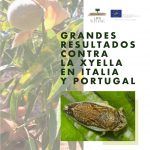
LIFE Resilience, a project co-funded by the European Union (EU) LIFE programme, whose main objective is the prevention of Xylella fastidiosa in high-density olive and almond orchards, is continuing its work to develop olive varieties that are as tolerant as possible to Xylella fastidiosa and other pathogens.
The Bioeconomy Institute of the Italian National Research Council (CNR IBE) has made great progress in recent months, having carried out soil sampling to study microbiological activity at the same sites taken in the first year.
In particular, the Italian partners have worked on the population dynamics of Philaenuss pumarius and Neophilae nuscampestris in olive groves. Two years of data collected on the presence of these two vectors in olive groves in Pisa, in their different stages, have led the researchers to observe that they are more present in juvenile stages, while adults disappear in summer and return in autumn.
In addition, an abundance of Philaenuss pumarius nymphs has been observed in different species of herbaceous plants sown to increase the biodiversity of the environment. environment. In particular, Calendula officinalis and Phaceliathanacetifolia, which remained around the crop the longest and are important hosts for different pollinators, are also hosts for the vector. Therefore, they pointed out that their role as useful plants in olive orchards should be better assessed.
Another conclusion of the Italian partners after evaluating Beauveriabassiana to control the presence of vector nymphs is that its efficacy has not been as good as expected. Therefore, they hope to re-evaluate by changing the dosage to try to obtain better results.
At the same time, a study has been carried out on the role of nymph foam in protecting against potential natural enemies such as spiders and ants. The result shows that when foam was present, it was difficult for the tested predators to attack the nymphs, so that control of nymphal stages of the vectors by natural enemies could be difficult. However, further studies on this topic could lead to new insights.
Following the search for natural enemies, the diversity of predators in the soil (pitfalltraps) has also been evaluated and ground beetles (carabids, staphylinids and spiders) have been found.
With regard to increasing the biodiversity of the environment with nest boxes and insect hotels, results indicate that boxes have been found to be colonised by the well-known insect-eating bird Parusmajor (great tit).
In addition, Salov has made great progress thanks to the relationship with the San Rossore Park (Italy), where they have managed to plant many typical Tuscan varieties, such as the Oleander (Neriumoleander L.). With this initiative, they have managed to increase the biodiversity of the environment, local birds and the creation of green corridors in the area.
For their part, Nutriprado researchers have made progress in recent months with regard to the use of plant covers against Xylella fastidiosa. Specifically, the partners carried out plant mixtures of species (tree and shrub) in the farms of El Valenciano (Seville) and El Charqueirão (Portugal), whose capture figures were highly influenced by the state of the plant cover. In Seville, the canopy was cut and completely dried out, making the existence of any arthropods unfeasible, while in Charqueirão, although some herbaceous plants were already dry, this favoured the existence of some insects.
At the same time, the Portuguese partners believe it is important to increase the levels of auxiliary fauna. important to increase the levels of auxiliary fauna within the cultivation plot in order to maintain a good and effective vegetation cover, given that cutting back too early causes a sharp drop in the number of individuals in general, but especially in auxiliary fauna that ends up not having shelters that allow them to survive.
